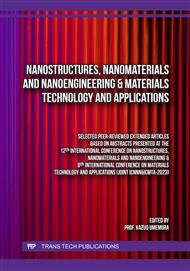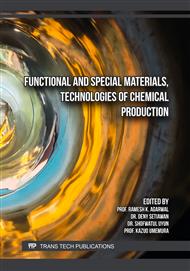[1]
L. Liu, G. Pan, L. Wang, X. Ren, X. Zhang and G. Wu. Hybrid hydrogels toughened by chemical covalent bonding and physical electrostatic interactions: Chem. Res. Chin. Univ. Vol. 34 (2018), pp.500-505.
DOI: 10.1007/s40242-018-7375-z
Google Scholar
[2]
C. Wang, Z. Shen, P. Hu, T. Wang, X. Zhang, L. Liang, J. Bai, L. Qiu, X. Lai, X. Yang and K. Zhang. Facile fabrication and characterization of high-performance Borax-PVA hydrogel: J. Sol-Gel Sci. Technol. Vol. 101 (2022), pp.103-113.
DOI: 10.1007/s10971-021-05584-0
Google Scholar
[3]
V. Sethi, M. Kaur, A. Thakur, P. Rishi and A. Kaushik. Unravelling the role of hemp straw derived cellulose in CMC/PVA hydrogel for sustained release of fluoroquinolone antibiotic: Int. J. Biol. Macromol. Vol. 222 (2022), pp.844-855.
DOI: 10.1016/j.ijbiomac.2022.09.212
Google Scholar
[4]
S. Bhaladhare and D. Das, Cellulose: a fascinating biopolymer for hydrogel synthesis: J. Mater. Chem. B Vol. 12 (2022), pp.1923-1945.
DOI: 10.1039/d1tb02848k
Google Scholar
[5]
J. Wu, X. Wu, F. Yang, X. Liu, F. Meng, Q. Ma and Y. Che. Multiply cross-linked poly(vinyl alcohol)/cellulose nanofiber composite ionic conductive hydrogels for strain sensors: Int. J. Biol. Macromol. Vol. 225 (2023), pp.1119-1128.
DOI: 10.1016/j.ijbiomac.2022.11.173
Google Scholar
[6]
B.A. Widyaningrum, P. Amanda, D.A. Pramasari, R.S. Ningrum, W.B. Kusumaningrum, Y.D. Kurniawan, A.N. Amenaghawon, H. Darmokoesoemo and H.S. Kusuma. Preparation of a conductive cellulose nanofiber-reinforced PVA composite film with silver nanowires loading: Nano-Struct. Nano-Objects. Vol. 31 (2022), p.100904.
DOI: 10.1016/j.nanoso.2022.100904
Google Scholar
[7]
J. Han, T. Lei and Q. Wu. High-water-content mouldable polyvinyl alcohol-borax hydrogels reinforced by well-dispersed cellulose nanoparticles: Dynamic rheological properties and hydrogel formation mechanism: Carbohydr. Polym. Vol. 102 (2014), pp.306-316.
DOI: 10.1016/j.carbpol.2013.11.045
Google Scholar
[8]
D. Monticelli, V. Martina, R. Mocchi, R. Rauso, U. Zerbinati, G. Cipolla and N. Zerbinati. Chemical characterization of hydrogels crosslinked with polyethylene glycol for soft tissue augmentation: Maced. J. Med. Sci. Vol. 7 (2019), pp.1077-1081.
DOI: 10.3889/oamjms.2019.279
Google Scholar
[9]
S. Tanpichai, F. Phoothong and A. Boonmahitthisud. Superabsorbent cellulose‑based hydrogels cross‑liked with borax: Sci. Rep Vol. 12 (2022), p.8920.
DOI: 10.1038/s41598-022-12688-2
Google Scholar
[10]
X. He, D. Zhang, J. Wu, Y. Wang, F. Chen and P. Fan. Mingqiang Zhong, Shengwei Xiao, Jintao Yang, One-pot and one-step fabrication of salt-responsive bilayer hydrogels with 2D and 3D shape transformations: ACS Appl. Mater. Interfaces Vol. 11 (2019), pp.25417-25426.
DOI: 10.1021/acsami.9b06691
Google Scholar
[11]
K. Chitbanyong, S. Pitiphatharaworachot, S. Pisutpiched, S. Khantayanuwong and B. Puangsin. Characterization of bamboo nanocellulose prepared by TEMPO-mediated oxidation: Bioresour. Vol. 13 (2018), pp.4440-4454.
DOI: 10.15376/biores.13.2.4440-4454
Google Scholar
[12]
N. Lu and S. Oza. Thermal stability and thermo-mechanical properties of hemp-high density polyethylene composites: Effect of two different chemical modifications: Compos. B: Eng. Vol. 44 (2013), pp.484-490.
DOI: 10.1016/j.compositesb.2012.03.024
Google Scholar
[13]
B. Ahmed, J. Gwon, M. Thapaliya, A. Adhikari, S. Ren, and Q. Wu. Combined effects of deep eutectic solvent and microwave energy treatments on cellulose fiber extraction from hemp bast: Cellul. Vol. 30 (2023), pp.2895-2911.
DOI: 10.1007/s10570-023-05081-3
Google Scholar
[14]
Y. Qin, J. Wang, C. Qiu, X. Xu and Z. Jin. A dual cross-linked strategy to construct moldable hydrogels with high stretchability, good self-recovery, and self-healing capability: Agric. Food Chem. Vol. 67 (2019), pp.3966-3980.
DOI: 10.1021/acs.jafc.8b05147
Google Scholar



